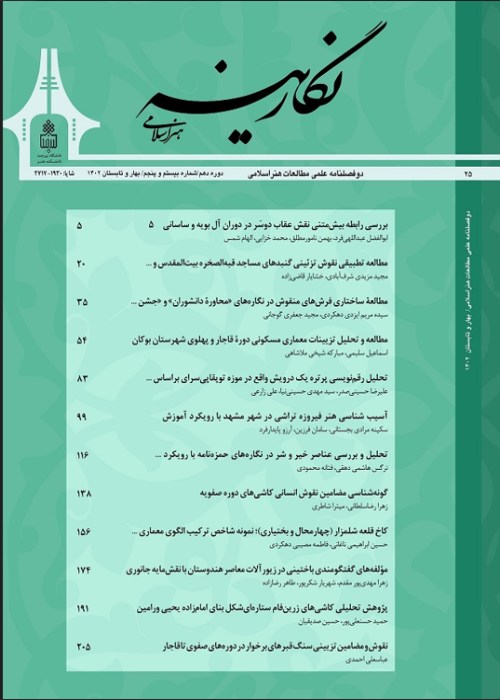The Status of Fabric And Paper Coverings on The Architectural Arrays of the Qajar Period In The House of Vasigh Ansari In Isfahan
The use of paper and fabric as architectural arrays in Iran is not very old. During the Qajar period, due to the expansion of trade relations with Europe and East Asia, luxurious wall coverings using fabric and paper found a special place in Iranian architectural arrays. Qajar wallpapers were placed and installed in palaces, mansions, castles of government heads, houses of the rich and merchants. Vasigh Ansari's House in Isfahan is one of the buildings with new wall coverings of the Qajar period. Based on field studies and surveys conducted on Vasigh Ansari's house, it was found that there are two widely used types of fabric and paper wall decorations that can be found in each of them various designs and themes. The main purpose of this research, is to introduce and categorize the motif of wall textile and wallpapers in Vasigh Ansari's house and to identify the cultures that influence the choice of motifs in these arrays. The most important research question is that what are the visual and thematic features of the existing motifs on the wall coverings of the Vasigh Ansari's house? And how to trace different cultures in these arrays. Findings show that plant motifs and sculptures are the most widely used motifs in the wall coverings of this house. Most of these motifs are not Iranian and the owners have ordered these covers according to the cultures of Western and East Asia. Geometric patterns derived from European architectural decorations are also in the next category. Also, reading the text and narrative image of the Wayang Theater in one of the covers shows the complete theme of this ancient Indonesian theater, which is probably produced in India. A unique inscription with the number and date on one of the covers introduces the time of production of some of these arrays during the reign of Zel-o-Sultan. This research has been done by descriptive-analytical method and data analysis by qualitative method. Data collection was based on field studies, image documentation, interviews, and the use of library resources and written documents
- حق عضویت دریافتی صرف حمایت از نشریات عضو و نگهداری، تکمیل و توسعه مگیران میشود.
- پرداخت حق اشتراک و دانلود مقالات اجازه بازنشر آن در سایر رسانههای چاپی و دیجیتال را به کاربر نمیدهد.



